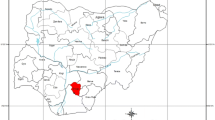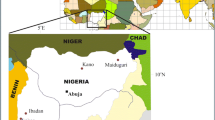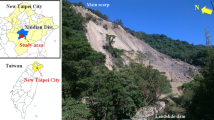Abstract
Using remote sensing data and geographic information system (GIS) analytical techniques, we investigated instability at Iva Valley where there is an anomalous concentration of landslide scars. The area has a fairly rugged topography caused to a large extent by the headward erosion by the east-flowing Ekulu River. Mass wasting is more pronounced on the poorly consolidated sandstone (Ajali) formation which (as a major aquifer) serves as the source of the Ekulu River and its tributaries. At the lower portion of the formation and the uppermost part of shale (Mamu) formation (fractured in some places), inter-bedded thin mudstone layers provide the sandstones additional resistance to erosion, which however leads to steeper slopes and very deep and narrow stream channels. Digital elevation models show that the landforms are dominantly lowlands and lowhills with landslides concentrated on river tributaries where failures on the incised slopes create further instability. The overlying sandstone formation seems inherently unstable because of its semi-consolidated and friable nature. The fractures (orientated NE-SW) in the underlying shale formation and the occasional removal of lateral support by mining or road construction probably aggravate the instability. Additional stress on the unstable sandy mass resulting from increase in self-weight and pore pressure during rainfall readily induces failure, which then steepens the slopes and renders them vulnerable to more collapse behaviors that create clusters of scars. The results show good agreement with field observations and literature data indicating the importance of remote sensing analysis, ASTER, and SRTM imagery in geomorphologic interpretations.










Similar content being viewed by others
References
Agagu OK, Adighije CI (1983) Tectonic and sedimentation framework of the lower Benue trough, southeastern Nigeria. J Afr Earth Sci 1:267–274
Akpokodje EG, Tse AC, Ekeocha N (2010) Gully erosion geohazards in southeastern Nigeria and management implications. Sci Afr 9:20–36
Aleotti P (2004) A warning system for rainfall-induced shallow failures. Eng Geol 73:247–265
Amajor LC (1987) Paleocurrent, petrography and provenance analyses of the Ajali sandstone (upper cretaceous) southeastern Benue trough. Niger Sed Geol 54:47–60
Anderson SA, Sitar N (1995) Analysis of rainfall-induced debris flow. J Geotech Eng 121:544–552
Banerjee I (1979) Analysis of cross-bedded sequences: an example from the Ajali sandstone (maastrichtian) of Nigeria. Quart J Geol Min Met Soc India 51:69–81
Benkhelil J (1989) The origin and evolution of the cretaceous Benue trough (Nigeria). J Afr Earth Sci 8:251–282
Chigira M (2001) Micro-sheeting of granite and its relationship with landsliding specifically after the heavy rainstorm in june 1999, Hiroshima prefecture, Japan. Eng Geol 59:219–231
Chigira M (2002) Geologic factors contributing to landslide generation in a pyroclastic area: august 1998 nishigo village, Japan. Geomorphology 46:117–128
Chigira M, Kiho K (1994) Deep-seated rockslide-avalanches preceded by mass rock creep of sedimentary rocks in the Akaishi mountains, central Japan. Eng Geol 38:221–230
Crosta G, Frattini P (2008) Rainfall-induced landslides and debris flows. Hydrol Process 22:473–477
Crozier MJ (1984) Field assessment of slope instability. In:Brunsden D, Prior DB (eds) Slope Instability. Wiley, Chichester, pp. 103-142, Chap. 4
Cruden DM, Varnes DJ (1996) Landslide types and processes. In: Turner AK, Schuster RL (eds) Special report 247: landslides investigation, mitigation. National Research Council, Transportation Research Board, Washington D.C., pp 36–75
Daba S, Rieger W, Strauss P (2003) Assessment of gully erosion in eastern Ethiopia using photogrammetric techniques. Catena 50:273–291
Fernandes NF, Guimaraes RF, Gomes RAT, Vieira BC, Montgomery DR, Greenberg H (2004) Topographic controls of landslides in Rio de Janeiro: field evidence and modeling. Catena 55:163–181
Fitton JG (1980) The Benue trough and Cameroon line—a migrating rift system in west africa. Earth Planet Sci Lett 51:132–138
Fourniadis IG, Liu JG, Mason PJ (2007) Landslide hazard assessment in the Three Gorges area, China, using ASTER imagery: Wushan–Badong. Geomorphology 84:126–144
Fukuoka M (1980) Landslides associated with rainfall. Geotech Eng 11:1–29
Gabet E, Burbank D, Putkonen J, Pratt-Sitaula B, Ojha T (2004) Rainfall thresholds for landsliding in the Himalayas of Nepal. Geomorphology 63:131–143
Gao J, Maro J (2010) Topographic controls on evolution of shallow landslides in pastoral Wairarapa, New Zealand, 1979–2003. Geomorphology 114:373–381
Gostelow P (1991) Rainfall and landslides. In: Almeida-Teixeira M (ed) Prevention and control of landslides and other mass movements. CEC, Brussels, pp 139–161
Guzzetti F, Carrara A, Cardinali M, Reichenbach P (1999) Landslide hazard evaluation: a review of current techniques and their application in a multi-scale study, central Italy. Geomorphology 31:181–216
Guzzetti F, Peruccacci S, Rossi M, Stark C (2008) The rainfall intensity–duration control of shallow landslides and debris flows: an update. Landslides 5:3–17
Highland LM, Bobrowsky P (2008) The landslide handbook—a guide to understanding landslides. Reston, Virginia. US Geol Surv Circ 1325:129
Hong Y, Hiura H, Shino K, Sassa K, Suemine A, Fukuoka H, Wang G (2005) The influence of intense rainfall on the activity of large-scale crystalline schist landslides in Shikoku Island, Japan. Landslides 2:97–105
Hoque M (1977) Petrographic differentiation of tectonically controlled cretaceous sedimentary cycles, southeastern Nigeria. Sed Geol 17:235–245
Hoque M, Ezepue MC (1977) Petrology and paleogeography of the ajali sandstone. J Min Geol 14:16–22
Hungr O, Evans SG, Bovis MJ, Hutchinson JN (2001) Review of the classification of landslides of the flow type. Environ Eng Geosci 7:221–238
Igwe O (2012) ICL/IPL regional activities in West Africa. Landslides 9:433–437
Igwe O (2013) ICL/IPL activities in West Africa: landslide risk assessment and hazard mapping approach. Landslides 10:515–521
Igwe O (2014) The role of weathering in the initiation and mobility of a rare complex avalanche at the Nigeria–Cameroon border, West Africa. Landslides 11:319–326
Igwe O, Fukuoka H (2010) Environmental and socioeconomic impact of erosion in Nigeria, West Africa. Inter J Ero Cont Eng 3:102–109
Igwe O, Mode W, Nnebedum O, Okonkwo I, Oha I (2013) The analysis of rainfall-induced slope failures at Iva Valley area of Enugu state. Nigeria. Env Earth Sci. doi:10.1007/s12665-013-2647-x
Igwe O, Mode W, Nnebedum O, Okonkwo I, Oha I (2015) The mechanism and characteristics of a complex rock-debris avalanche at the Nigeria-Cameroon border, West Africa. Geomorphology 234:1–10
Jakob M, Weatherly H (2003) A hydroclimatic threshold for landslide initiation on the north shore mountains of Vancouver, British Columbia. Geomorphology 54:137–156
Katsube K, Oguchi T (1999) Altitudinal changes in slope angle and profile curvature in the Japan alps: a hypothesis regarding a characteristic slope angle. Geogr Rev Jpn 72B:63–72
Kawabata D, Oguchi T, Katsube K (2001) Effects of geology on slope angles in the southern Japanese alps—a GIS approach. Trans Jpn Geomorphol 22:827–836
Kogbe CA (1981) Attempt to correlate the stratigraphic sequence in the middle Benue basin with those of the anambra and upper Benue basins. Earth Evo Sci 2:139–143
Kogbe CA (1989) Palaeogeographic history of Nigeria from albian times. In: Kogbe CA (ed) Geology of Nigeria. Elizabethan Publ.Co, Lagos, pp 257–275
Ladipo KO (1986) Tidal shelf depositional model for the ajali sandstone, anambra basin, southeastern Nigeria. J Afr Earth Sci 5:177–185
Marzolff I, Poesen J (2009) The potential of 3D gully monitoring with GIS using high-resolution aerial photography and a digital photogrammetry system. Geomorphology 111:48–60
Matsushi Y, Matsukura Y (2007) Rainfall thresholds for shallow landsliding derived from pressure-head monitoring: cases with permeable and impermeable bedrocks in Boso Peninsula, Japan. Earth Surf Proc Land 32:1308–1322
Mejia-Navarro M, Wohl EE, Oaks SD (1994) Geological hazards, vulnerability and risk assessment using GIS: model for Glenwood springs, Colorado. Geomorphology 10:331–354
Oguchi T (1996) Factors affecting the magnitude of post-glacial hillslope incision in Japanese mountains. Catena 26:171–186
Oguchi T, Saito K, Kadomura H, Grossman M (2001a) Fluvial geomorphology and paleohydrology in Japan. Geomorphology 39:3–19
Oguchi T, Tanaka Y, Kim T, Lin Z (2001b) Large-scale landforms and hillslope processes in Japan and Korea. Trans Jpn Geomorphol 22:321–336
Okimura T, Kawatani T (1987) Mapping of the potential surface-failure sites on granite slopes. In: Gardiner E (ed) International geomorphology 1986, part I. Wiley, Chichester, pp 121–138
Olabode SO (2014) Soft sediment deformation structures in the maastrichtian ajali formation western flank of anambra basin, Southern Nigeria. J Afr Earth Sci 89:16–30
Pirasteh S, Pradhan B, Safari HO, Ramli MF (2013) Coupling of DEM and remote-sensing-based approaches for semi-automated detection of regional geostructural features in Zagros mountain. Iran Arab J Geosci 6:91–99
Pradhan B, Youssef AM (2009) Manifestation of remote sensing data and GIS on landslide hazard analysis using spatial-based statistical models. Arab J Geosci 3:319–326
Prasannakumar V, Vijith H, Geetha N (2013) Terrain evaluation through the assessment of geomorphometric parameters using DEM and GIS: case study of two major sub-watersheds in Attapady, South India. Arab J Geosci 6:1141–1151
Rao VR, Kumaran KPN (1981) Early angiosperm remains from the ajali sandstone, southeastern Nigeria. J Min Geol 18:172–174
Reyment RA (1965) Aspects of the geology of Nigeria: the stratigraphy of the cretaceous and cenozoic deposits. Ibadan University Press, 145p
Saito H, Nakayama D, Matsuyama H (2010) Relationship between the initiation of a shallow landslide and rainfall intensity—duration thresholds in Japan. Geomorphology 118:167–175
Sassa K (1988) Geotechnical model for the motion of landslides. In: Proc. 5th International Symposium on Landslides, “Landslides”, Balkema, Rotterdam, vol. 1. pp 37–56
Sassa K, Takei A, Kobashi S (1980) Landslides triggered by vertical subsidences. In: Proc. International symposium on landslides. New Delhi, 7–11 April 1980, 1:49–54
Sassa K, Wang G, Fukuoka H (2003) Performing undrained shear tests on saturated sands in a new intelligent-type of ring shear apparatus. Geotech Test J 26(3):257–265
Sassa K, Wang G, Fukuoka H, Wang FW, Ochiai T, Sekiguchi T (2004) Landslide risk evaluation and hazard mapping for rapid and long-travel landslides in urban development areas. Landslides 1:221–235
Schulz WH (2007) Landslide susceptibility revealed by LIDAR imagery and historical records, Seattle, Washington. Eng Geol 89:67–87
Schwab M, Rieke-Zapp D, Liniger M, Schlunegger F (2008) Landsliding and sediment flux in the Central Swiss Alps: a photogrammetric study of the Schimbrig landslide, Entlebuch. Geomorphology 97:392–406
Selby MJ (1993) Hillslope materials and processes, 2nd edn. Oxford University Press, New York, p 451
Tijani MN, Nton ME (2009) Hydraulic, textural and geochemical characteristics of the ajali formation, anambra basin, Nigeria: implication for groundwater quality. Environ Geol 56:935–951
Tsai TL, Chen HF (2010) Effects of degree of saturation on shallow landslides triggered by rainfall. Environ Earth Sci 59:1285–1295
Tsai TL, Wang JK (2011) Examination of influences of rainfall patterns on shallow landslides due to dissipation of matric suction. Environ Earth Sci 63:65–75
Udo RK (1970) Geographical regions of Nigeria. Heinemann, London, p 212
Wieczorek GF (1984) Preparing a detailed landslide-inventory map for hazard evaluation and reduction. Bull Assoc Eng Geol 21:337–342
Wright JB (1968) South Atlantic continental drift and the Benue trough. Tectonophysics 6:301–310
Yalcin A, Bulut F (2007) Landslide susceptibility mapping using GIS and digital photogrammetric techniques: a case study from Ardesen (NE-Turkey). Nat Hazards 41:201–226
Zhang LL, Zhang LM, Tang WH (2005) Rainfall-induced slope failure considering variability of soil properties. Geotechnique 55:183–188
Acknowledgments
The research was part of the World Centre of Excellence on Landslide Project approved for the Department of Geology, University of Nigeria by the International Program on landslides under the directorship of Professor Kyoji Sassa. We are indeed grateful to Professor Hiroshi Fukuoka of Niigata University for taking the pains to come for the field investigations and human capacity development programs.
Author information
Authors and Affiliations
Corresponding author
Rights and permissions
About this article
Cite this article
Igwe, O. The study of the factors controlling rainfall-induced landslides at a failure-prone catchment area in Enugu, Southeastern Nigeria using remote sensing data. Landslides 12, 1023–1033 (2015). https://doi.org/10.1007/s10346-015-0627-9
Received:
Accepted:
Published:
Issue Date:
DOI: https://doi.org/10.1007/s10346-015-0627-9




